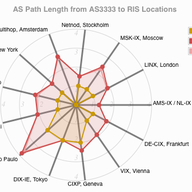
RIPEstat Live Demo #10
• 6 min read
This article provides a summary of the RIPEstat live demo session held on Monday, 31 October 2011 at RIPE 63 in Vienna. The focus of this demo was to review all current features, show some use cases of RIPEstat, and an provide an overview of planned developments. Information about the next demo ca…













“Hi, I am the project manager of the zonemaster (zonemaster.net) dns validation tool (https://github.com/zonemaster/zonemaster/blob/master/README.md). This open source tool is developed by Afnic (the French registry) and IIS (the Swedish registry). This tool is used by RIPE to validate the reverse IP address in the RIPE database. IMHO, it is the best available tool for DNS zone validation (everything open (BSD-2 licence for source code and Creative Commons Attribution 4.0 International License for the documentation) and with extensive documentation of all its modules and test cases) and it used by many well known DNS registries and registrars. My question is - will it be possible to integrate Zonemaster source code to verify a domain 's zone from different vantage points from RIPE root anchors? If you have any feedback to provide, please contact me at sandoche.balakrichenan@afnic.fr”
It's not entirely clear if you want to add RIPE Atlas support to zonemaster (then you can simply call APIs and integrate results that come back) or the other way around (adding zonemaster code to anchors -- which is much harder to do due to differences in working models).
“That is a rather powerful VM (the TL-MR3020 probes has 32MB ram and a Atheros AR9331@400MHz). Do the VM need to be so powerful? I would love to participate with a probe, if I could run a probe on my (weak) Intel Atom server, either as a VM or in some sort of container (systemd-nspawn/docker?). I will be more than happy to experiment if I could get access to the anchor.ks file (fell free to mail me at firstname@lastname.dk).”
There's need for more resources for an anchor than for a probe. It has services on it, for example. About probe VMs: we're looking into the possibility to introduce "software probes" deployable as a software package or such. We'll report back on this activity when we have more information.
“Given the proliferation of cheap single board computers such as the Raspberry Pi and/or most organisations having a virtualization platform of some sort, wouldn't the development of one or more images for these platforms be a better solution than tying the organisation to a single hardware vendor?”
Besides working with the above mentioned hardware, we're talking to other vendors to see what they can offer. One constraint is that we want to avoid using fully repurposeable hardware (like the Raspberry Pi) -- we fear that too many would be taken as "free hardware". We're also looking into virtual solutions: a VM anchor pilot is already ongoing. We will likely work more in this space.
“Hello, Is it possible to use INRDB and how? I need to search if an Internet prefix was announced on the Internet between 2012 and 2013, by which AS, for how long etc. Can you please help me?”
Hi, you should check out RIPEstat, specifically the routing history widget: https://stat.ripe.net/widget/routing-history#w.resource=193.0.0.0%2F21
“I also wonder whether the type of person hosting a probe has changed over time. At first it may have been more engaged "enthusiasts" who were personally keen to have a probe and ensure it remain connected. Later participants may have agreed to host a probe based on encouragement from an ambassador, but they don't really care as much or notice when their probe has disconnected.”
Indeed, this is a likely cause. However, it's difficult to measure such an effect.
Showing 15 comment(s)